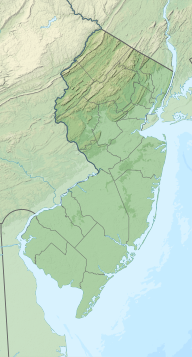
Otisco Lake is the easternmost of New York's eleven Finger Lakes. The 2,048-acre (8.29 km2) lake is located in Onondaga County, southwest of the city of Syracuse.
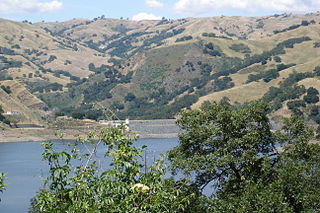
Calaveras Reservoir is located primarily in Santa Clara County, California, with a small portion and its dam in Alameda County, California. In Spanish, Calaveras means "skulls".

The Manasquan River is a 26.5-mile-long (42.6 km) waterway in central New Jersey.

The Metropolitan Water District of Southern California is a regional wholesaler and the largest supplier of treated water in the United States. The name is usually shortened to "Met," "Metropolitan," or "MWD." It is a cooperative of fourteen cities, eleven municipal water districts, and one county water authority, that provides water to 19 million people in a 5,200-square-mile (13,000 km2) service area. It was created by an act of the California State Legislature in 1928, primarily to build and operate the Colorado River Aqueduct. Metropolitan became the first contractor to the State Water Project in 1960.

The Mokelumne River is a 95-mile (153 km)-long river in northern California in the United States. The river flows west from a rugged portion of the central Sierra Nevada into the Central Valley and ultimately the Sacramento–San Joaquin River Delta, where it empties into the San Joaquin River-Stockton Deepwater Shipping Channel. Together with its main tributary, the Cosumnes River, the Mokelumne drains 2,143 square miles (5,550 km2) in parts of five California counties. Measured to its farthest source at the head of the North Fork, the river stretches for 157 miles (253 km).

A combination of aqueducts, reservoirs, and tunnels supplies fresh water to New York City. With three major water systems stretching up to 125 miles (201 km) away from the city, its water supply system is one of the most extensive municipal water systems in the world.

The Lansing Board of Water & Light is a publicly owned, municipal utility that provides electricity and water to the residents of the cities of Lansing and East Lansing, Michigan, and the surrounding townships of Delta, Delhi, Meridian and DeWitt. The Lansing Board of Water & Light also provides steam and chilled water services within the City of Lansing.
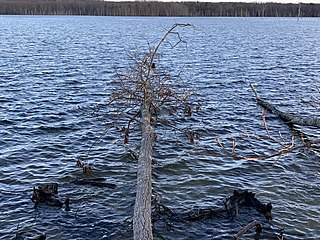
The Manasquan Reservoir is a source of water for municipalities and utilities, as well as a 1,204-acre (4.87 km2) park, located in Howell Township, in Monmouth County, New Jersey, United States. The reservoir doubles as a park that is part of the Monmouth County Park System. The park has trails, a visitor's center, a nature/environmental center, a boat launching area and several dikes for fishing, among its facilities. The reservoir itself, which is dammed from the Manasquan River, is operated by the New Jersey Water Supply Authority, which is a part of the much larger Raritan Basin Watershed. The nature trails circling around the reservoir are what makes this county park as one of the most popular hiking destinations in Central New Jersey, as the park receives over one million visitors a year. It is reachable by car and there are five parking lots, including one for vehicles hauling trailers. The park's trails are open to walkers, runners, hikers, bicyclists and equestrians.
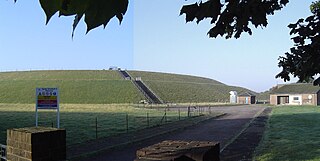
The Queen Elizabeth II Reservoir lies to the south of the River Thames and to the west of the Island Barn Reservoir. To the north are the Bessborough and Knight reservoirs. The A3050 runs to the north of the reservoir and it is situated in Walton on Thames. It is managed by Thames Water.
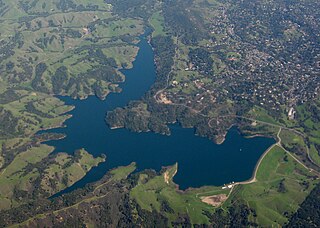
Briones Reservoir is an open cut terminal water storage reservoir located in western Contra Costa County, in the East Bay region of the San Francisco Bay Area, California.

The Los Vaqueros Reservoir and watershed is located in the northern Diablo Range, within northeastern Contra Costa County, northern California. It was completed by the Contra Costa Water District (CCWD) in 1998 to improve the quality of drinking water for its 550,000 customers in Central and Eastern Contra Costa County. The reservoir is accessible via Vasco Road, a road which connects Brentwood and Livermore.

The Hackensack Water Company Complex is a set of historic buildings in Weehawken, New Jersey, registered in the U.S. National Register of Historic Places. The Hackensack Water Company, a predecessor of Suez North America, developed water supply and storage in northeastern New Jersey from the 1870s to the 1970s, initially to provide service to the city of Hackensack and the towns of North Hudson. Originally its headquarters and major facilities were located at Hackensack, in Bergen County. Under Robert W. de Forest, who ran the Hackensack Water Company for 46 years beginning in 1881, the company constructed new facilities and moved its headquarters to Weehawken in Hudson County, setting up offices in a brick water tower, part of the present complex.
The Portland Water Bureau is the municipal water department for the city of Portland in the U.S. state of Oregon. The bureau manages a water supply that comes mainly from the Bull Run River in the foothills of the Cascade Range east of the city and secondarily from the Columbia South Shore Well Field near the Columbia River. As of 2023, Mingus Mapps was the city commissioner in charge of the bureau, and the chief administrator is Michael Stuhr. Budgeted departmental revenues for fiscal year 2015–16 included about $157 million for charges for services.

The South Central Connecticut Regional WaterAuthority is a public water supply utility in Connecticut, United States. The RWA supplies water in a 15-town region with a population of about 430,000. The RWA acts as a steward of the environment in the local region by protecting more than 26,000 acres of watershed lands, and promoting sustainability.
The Marin Municipal Water District is the government agency that provides drinking water to southern and central Marin County, California. Chartered in 1912, it became California's first municipal water district. It serves 191,000 customers in a 147-square-mile (380 km2) area that includes ten towns and cities.

The British Engineerium is an engineering and steam power museum in Hove, East Sussex. It is housed in the Goldstone Pumping Station, a set of High Victorian Gothic buildings started in 1866. The Goldstone Pumping Station supplied water to the local area for more than a century before it was converted to its present use. The site has been closed to the public since 2006, and in March 2018 the entire complex was put up for sale.

Griffy Reservoir, commonly known as Lake Griffy, is a reservoir in the city of Bloomington, Indiana. Created by a dam on Griffy Creek in the 1920s, the reservoir used to serve as the main source of drinking water for Bloomington for several decades, until that role was taken over by the larger Lake Lemon and Lake Monroe in the 1950s.
Wolffs Run is a tributary of Stony Creek in Luzerne County, Pennsylvania. It is approximately 0.4 miles (0.64 km) long and flows through Hazle Township. The watershed of the stream has an area of 0.6 square miles (1.6 km2). A reservoir known as the Humboldt Reservoir is located on it. The reservoir serves as a water supply and is dammed by the Humboldt Dam.
Barnes Run is a tributary of Black Creek in Luzerne County, Pennsylvania. It is approximately 2.2 miles (3.5 km) long and flows through Black Creek Township. The stream has been used as a water supply for portions of Hazleton and some surrounding areas. It is designated as a Coldwater Fishery and wild trout naturally reproduce within it.

